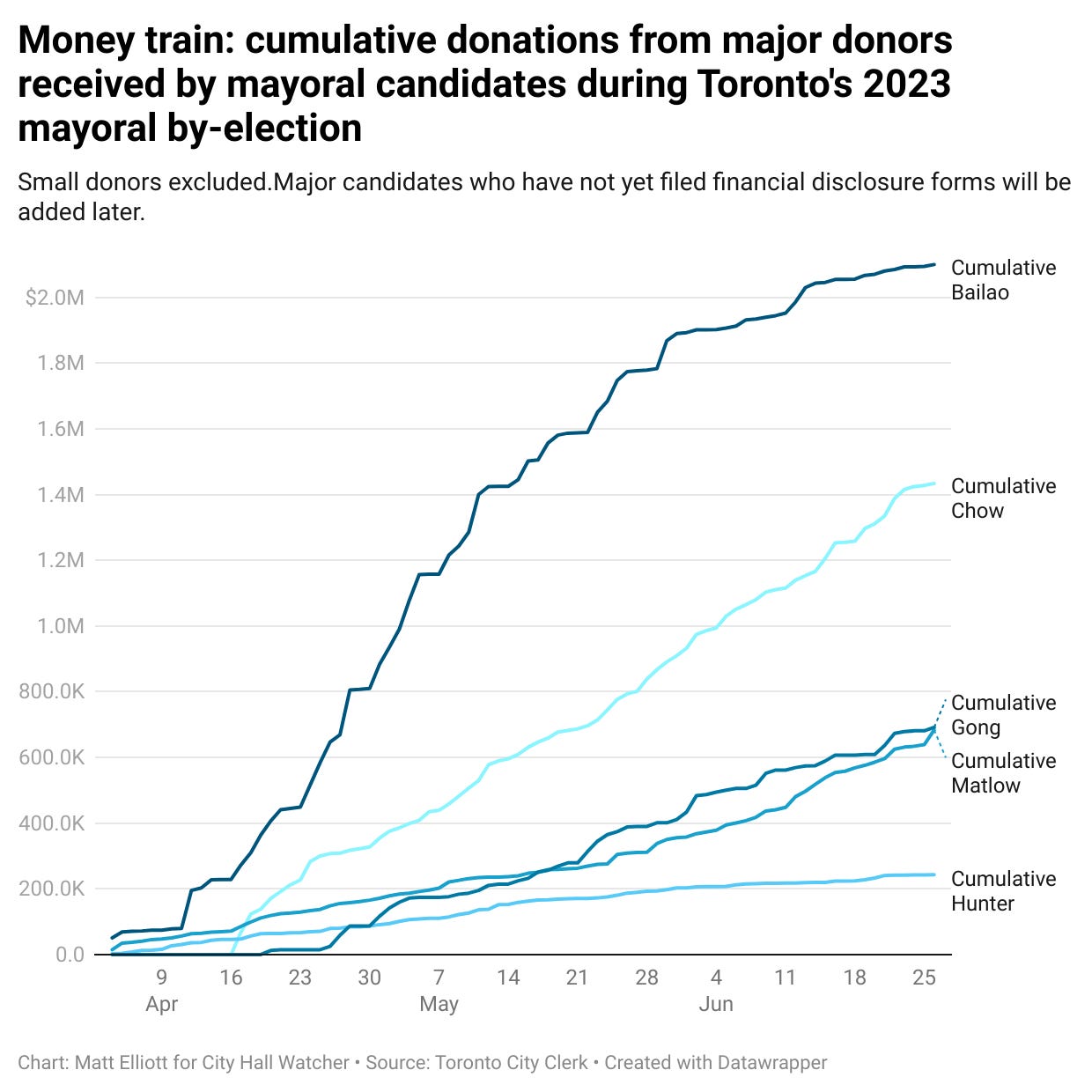Toronto's toxic supply
City Hall Watcher #245: Matthew Alexandris on the data and root causes of Toronto's overdose crisis, plus a look at the day-by-day of by-election campaign finance
Hey there!
Welcome to another fine edition of City Hall Watcher. This week, we’ve got a returning special guest contributor, as Matthew Alexandris looks into some recent data on overdoses in the city. Don’t blame safe consumption sites — blame toxic supply.
In addition, today’s issue contains a couple of graphics from me as I look at the financial filings from the mayoral by-election, identifying the best fundraising days for some of the major candidates to file so far.
— Matt Elliott
@GraphicMatt / graphicmatt@gmail.com / CityHallWatcher.com
Read this issue on the web / Browse the archives / Subscribe
Overdose data points to toxic drug supply
By Matthew Alexandris
The number of deaths caused by opioid toxicity is down after peaking during the height of the COVID-19 pandemic, but fatal incidents remain well above pre-pandemic levels.
Experts have pointed to changing access to health care services and community-based programs as a factor for rising opioid-related overdoses. During the pandemic, people who use drugs had less access to injection sites and were more likely to be in isolation when using due to public health measures to limit the spread of COVID-19. Under these conditions, drug users were less connected with their healthcare practitioners and other drug users to help if an overdose occurred.
The data supports this conclusion. In 2022, naloxone use was reported in 23% of accidental opioid toxicity deaths (there was missing information in 21% of cases). In 63% of cases where naloxone use was reported, it was administered by bystanders. Having people around makes a significant difference.
In that light, the pandemic had an acute effect on people in Toronto experiencing homelessness as many shelters had to adapt to the public health measures, including physical distancing and isolation, or rush to turn hotel sites into shelters, but these shelters were not equipped with the strategies and resources to give drug users a safe respite.
Under these conditions, the amount of fatal overdose incidents skyrocketed.
With vaccinations becoming widespread and shelters adapting to the conditions, the number has dropped from its peak, but there’s no obvious explanation for why the amount of overdoses remains above pre-pandemic levels.
Some commentators and politicians have pointed to safe supply programs and safe consumption sites as a cause for the growing amount of overdose incidents. However, data from The Works, a group of safe injection sites for people to use pre-obtained drugs under the supervision of a trained healthcare professional run by Toronto Public Health, suggests the opposite.
The peak of visits to the supervised consumption sites run by the Works was in the months leading up to the pandemic. During that time, there were nearly 4,000 visits some months, but there were never more than 75 incidents in a given month where an overdose occurred. There was a total of 634 overdose incidents for all of 2019.
However, throughout 2021, there were never more than 2,000 visits in a given month, but there were 1,102 incidents where an overdose occurred. The number of overdose incidents peaked in December 2021 at 175 — more than double the number of incidents in any month during 2019.
The clear takeaway is that the pre-obtained drugs taken from the streets have become more toxic. Toronto Public Health’s Drug Checking Service has confirmed this finding. For example, drug samples collected that were expected to be opioids continued to be more contaminated than other drugs: only 6% of expected fentanyl substances contained only fentanyl. Moreover, there has been an increasing presence of benzodiazepines (and benzodiazepine-related drugs) in larger proportions and an increasing number of analyzed opioid samples.
It seems likely that the crisis will persist unless there is a stronger response by the government to address the toxicity of drugs on the street and that drug use can be done safely under the supervision of trained healthcare professionals. But Toronto Public Health’s Drug Checking Service is without a long-term funding commitment and has begun to wind down various aspects of the service, as of April 1, 2023, according to their website.
In 2021, Toronto Medical Officer of Health Dr. Eileen De Villa issued a report calling for the Board of Health to urge the Federal and Provincial Governments to decriminalize drug possession under the Controlled Drugs and Substances Act and remove the current cap of 21 Consumption and Treatment Services permitted in Ontario, respectively. The report also called on both governments to provide a long-term financial commitment to assist the City of Toronto with programs to create and operate more affordable and supportive homes for people in need — including those who use drugs.
The overdose data suggests all of that — and more — is needed. Still, it is difficult to imagine the federal government — who have been cold to recent City requests for additional funding — or the provincial government — with Ford’s general disapproval of the harm reduction approach — coming to the rescue to provide financial support.
That leaves the City to address the crisis. In her mayoral campaign, Mayor Olivia Chow agreed with Toronto’s application for the decriminalization of drugs, but did not expand on how she would use her powers as mayor to address the opioid crisis. Chow will need to make strategic choices for how she will bolster city revenues and use them to fund Toronto’s response to the crisis.
Matthew Alexandris is a freelance writer interested in issues related to housing based in the Greater Toronto Area. You can follow him on Twitter here.








